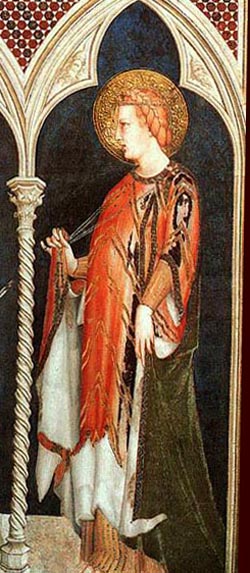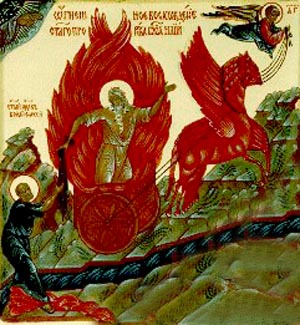 |
The Saint of the Day
St. Elizabeth of Hungary, November 19
Prof. Plinio Corrêa de Oliveira
Biographical selection:

St. Elizabeth of Hungary
Detail from Piero Martini's fresco
St. Clare and St. Elizabeth of Hungary |
The fame of the virtues of St. Elizabeth [1207-1231] reached Italy where St. Francis of Assisi had founded his order. He came to know about the support and protection the young Duchess of Thuringia had given the Franciscans in Germany and her great love for poverty. Cardinal Ugolini, the future Pope Gregory IX, often spoke of her to Francis.
One day the Cardinal asked St. Francis for a gift for her as a symbol of his recognition. As he made his request, he took the worn cape off St. Francis’ shoulders and recommended that he send it to her. “Since she is filled with your spirit of poverty,“ said the Cardinal, “I would like for you to give her your mantle, just as Elias gave his mantle to Eliseus.” St. Francis obeyed and sent his mantle to St. Elizabeth, whom he considered as a daughter.
She always kept it with her, and wore it while praying whenever she desired to obtain a special spiritual grace. Later, after she had lost everything, she still conserved the precious mantle of her spiritual father until her death.
Comments of Prof. Plinio:
This incident is rich in teachings for us.
St. Francis of Assisi followed the advice of Cardinal Ugolino, the future Pope Gregory IX, and imitated the example of Elias with Eliseus. He gave his mantle to St. Elizabeth, and when she prayed she used to wear it to be more pleasing to God. She had the certainty that the mantle St. Francis had worn was a symbol of his alliance with her, a symbol of the union of the two souls, and, therefore, a symbol that would draw from God the same graces that St. Francis attracted.
Underlying this incident is a theory about symbols like this.
Rebecca advised her son Jacob to wear a goat skin and approach his blind father Isaac so that he would seem like Esau and receive the blessing due the first born. This covering made Jacob pleasing to his father because he was vested in a way that gave the impression he was the first born. In this episode we have the affirmation of a principle according to which, in certain circumstances, a person who takes on the appearance of another can receive from God the privileges due to the other person.

From the fiery chariot Elias drops his mantle upon Eliseus |
Something similar happened with Eliseus. By putting on the mantle of Elias, he earned the privilege of being treated by God as if he were Elias. He was the perfect disciple of Elias, the favorite of Elias, he was a kind of extension of the personality of Elias. The mantle Elias gave to Eliseus was a symbol of this union of spirit.
Likewise, in a manner infinitely higher, we have Our Lord Jesus Christ, Who took on human flesh, suffered the Passion and the Crucifixion for us, and washed our sins with His Blood. The merit of His Blood covers us, as the mantle of Elias covered Eliseus. With this red mantle we can present ourselves before God Who is thus pleased to receive us, forgive us, and give us the graces necessary for repentance and the amendment of our lives. We are able to appear before God because we are clothed in the mantle of the innocence and the suffering of Christ and with this, we take on His appearance.
Something like this takes place with Our Lady. She takes the initiative of covering us with her mantle. Then she says to God: “I vest these children with my merits as their mother, and I want You to consider them as my children.” So, Our Lord looking at us, sees extensions of the personality of Our Lady, and becomes pleased, forgives us, and tries to help us.
In all these episodes – Jacob and Isaac, Eliseus and Elias, St. Elizabeth and St. Francis, Our Lady with us, and us with Our Lord – there is some special union of souls that allows one soul to be clothed with the merits of another in order to appear before the Throne of God and be pleasing to Him.
We can apply this principle to our lives. We should have confidence and not despair in face of our weaknesses and guilt. One of us can approach God and say: “Do not look at my sins, but see instead the merits of your Son and the intercession of Our Lady.”
We should have the honesty to see our defects and sins, because this is what we are supposed to do, but we should not despair, since even if our sins are great we can present ourselves before God vested in the merits of Our Lady and Our Lord. We should have confidence that this marvelous chain of substitutions will be accepted with pleasure by the infinite mercy of God.


  | | Prof. Plinio Corrêa de Oliveira | |
The Saint of the Day features highlights from the lives of saints based on comments made by the late Prof. Plinio Corrêa de Oliveira. Following the example of St. John Bosco who used to make similar talks for the boys of his College, each evening it was Prof. Plinio’s custom to make a short commentary on the lives of the next day’s saint in a meeting for youth in order to encourage them in the practice of virtue and love for the Catholic Church. TIA thought that its readers could profit from these valuable commentaries.
The texts of both the biographical data and the comments come from personal notes taken by Atila S. Guimarães from 1964 to 1995. Given the fact that the source is a personal notebook, it is possible that at times the biographic notes transcribed here will not rigorously follow the original text read by Prof. Plinio. The commentaries have also been adapted and translated for TIA’s site.
|
Saint of the Day | Home | Books | CDs | Search | Contact Us | Donate

© 2002- Tradition in Action, Inc. All Rights Reserved
|
 |

|